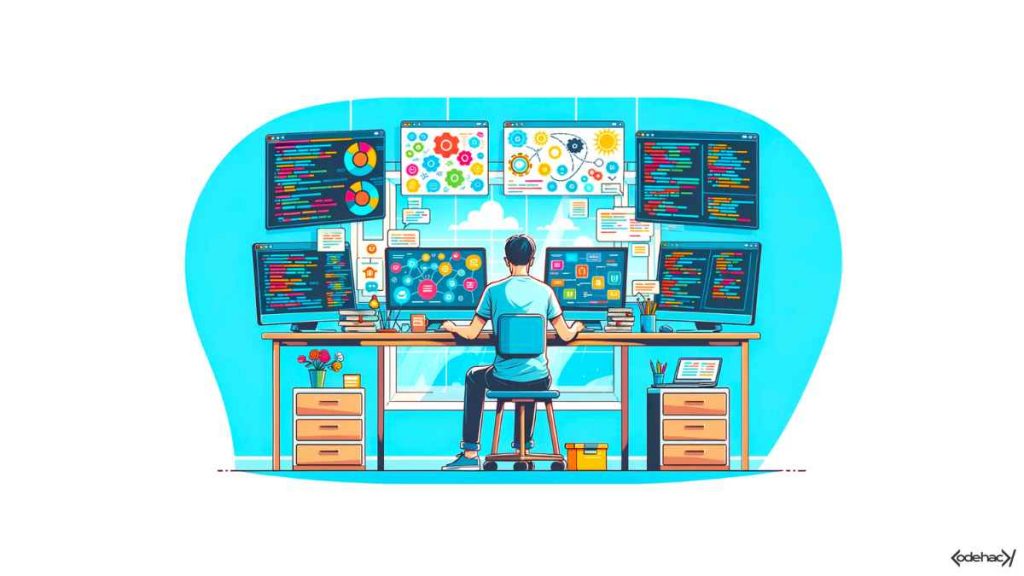Programmers continually seek tools to streamline and enhance their thought processes. Among these tools, mind mapping emerges as a powerful ally, offering a unique approach to organizing and expanding coding thoughts.
What is Mind Mapping?
Mind mapping is a method of visually organizing information. It starts with a central idea and expands outward in a radial manner, connecting related sub-ideas, tasks, or data points. It’s a way of thinking and organizing thoughts more effectively.
Why Mind Mapping for Programmers?
Programming involves dealing with complex structures, algorithms, and multiple layers of abstraction. Mind maps help in breaking down these complexities into simpler, more manageable parts. They enable programmers to see the bigger picture and the intricate details simultaneously, making it easier to understand how different parts of a program interact with each other.
Benefits of Mind Mapping in Programming:
- Enhanced Clarity and Organization: By visually mapping out code structures and algorithms, programmers can gain a better overview of their projects, leading to more efficient and effective coding.
- Improved Problem-Solving Skills: Mind mapping encourages lateral thinking, enabling programmers to explore multiple solutions to a given problem.
- Facilitated Collaboration: Sharing mind maps among team members can enhance understanding and communication, crucial in collaborative coding environments.
- Efficient Debugging and Refactoring: Visual representations of code can simplify the identification of errors and areas for improvement.
- Better Memory Retention: Visual cues in mind maps aid in better retention and recall of information.
- Effective Time Management: Integrating mind mapping into daily routines can significantly streamline project timelines, aiding programmers in managing their tasks more efficiently and effectively.
Studies have shown that mind mapping can be an effective tool for learning and problem-solving. For instance, a study by Cunningham in 2005 found that 80% of students believed mind mapping helped them understand concepts better in science. While these studies are not specific to programming, they do indicate the potential benefits of mind mapping in complex cognitive tasks like software development.

Mind Mapping Techniques for Programmers:
A mind map is a diagram that organizes information into a hierarchy, showing relationships among various elements. It starts with a single central concept, from which related ideas branch out. This radial hierarchy is ideal for programmers who need to keep track of multiple components and their interconnections.
Here is the mind mapping techniques tailored for programming:
- Identify the Core Concept: Begin with the main functionality or problem you’re addressing. This could be a specific feature of the software or a particular algorithm you’re developing.
- Branch Out Logically: Create branches for different modules, functions, classes, or sub-tasks. This helps in breaking down complex code into more manageable sections.
- Use Visual Cues: Employ colors, symbols, and images to differentiate between various parts of the code. This not only makes the mind map more engaging but also aids in quicker comprehension and recall.
- Iterative Development: As your project evolves, so should your mind map. Regularly update it to reflect changes and additions to your code.
- Linking to Code: Some mind mapping software allows you to link parts of your map directly to code snippets, documentation, or other digital resources, creating a more integrated development environment.
Best Mind Mapping Tools for Programmers:
Mind maps are simple to create and they don’t require any special tools — a piece of paper and a pen are enough to get started. However, several digital tools can enhance the experience by allowing integration with other software, enabling the linking of code snippets, documentation, and other resources directly into the mind map. Here’s a detailed look at some of the prominent mind mapping tools that can revolutionize the way programmers plan and execute their code.

- Freeplane: This open-source tool is a favorite among programmers for its versatility in mind mapping. It allows for dynamic hierarchical structuring, making it ideal for mapping complex code structures. Its integration with LaTeX is particularly beneficial for those who deal with scientific computing.
- XMind: Known for its user-friendly interface, XMind is a popular choice for creating mind maps, spreadsheets, and org charts. It supports various diagram types, including fishbone diagrams and tree charts, making it a versatile tool for different aspects of programming.
- MindMeister: This web-based tool stands out for its collaborative features, allowing multiple users to work on a mind map simultaneously. It’s particularly useful for team projects in programming, where brainstorming and collective idea development are crucial.
- Coggle: A freemium tool that excels in simplicity and ease of use. Its ability to create complex hierarchical structures with a minimalistic approach makes it a go-to for programmers who prefer clarity and straightforwardness in planning.
- MindMup: This browser-based tool integrates seamlessly with Google Drive and GitHub, offering a convenient way for programmers to store and share their mind maps. Its adaptability to both mobile and desktop interfaces is a significant advantage for programmers on the go.
- SimpleMind: Known for its intuitive design, SimpleMind caters to programmers who seek a straightforward and efficient way to visualize their coding projects. Its flexibility in customization and layout options makes it a robust tool for individual and team use.
- LucidChart: This tool is renowned for its advanced collaborative features, making it ideal for programming teams. It supports real-time collaboration and offers a range of diagramming tools that are useful for mapping complex software architectures.
- Mindjet MindManager: A comprehensive tool that integrates well with Microsoft Office products. It’s particularly useful for programmers who require advanced project management features, such as Gantt charts and task management within their mind maps.
- Edraw Max: This tool offers a vast library of cliparts and symbols, making it ideal for creating detailed and visually appealing mind maps. Its compatibility with various file formats and integration with Gantt charts makes it a versatile tool for programmers.
- TheBrain: Unique for its graphical intensive interface, TheBrain is suitable for programmers who prefer a more visual and interactive approach to mind mapping. Its ability to create highly interconnected maps makes it ideal for complex programming projects.
Each of these tools offers unique functionalities to suit different programming needs, from individual brainstorming to collaborative project planning.
For programmers, mind mapping is more than just a tool for organization. It’s a way to visually structure and navigate the complexities of code, enhance problem-solving skills, and improve collaboration. By adopting mind mapping techniques, programmers can gain a clearer understanding of their projects, leading to more efficient and effective coding practices.
